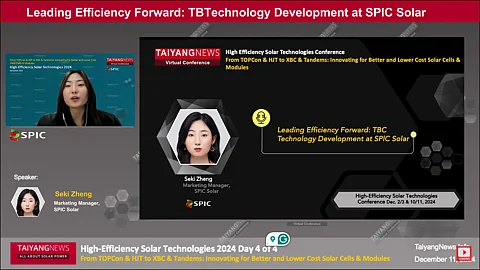

SPIC Solar is shifting from p-poly IBC to TBC cell technology based products
The ANDROMEDA 3.0 series module portfolio is based on TBC cells with a mass-scale efficiency of up to 26.08%
The ANDROMEDA 3.0 TBC module portfolio includes both dual-glass and monofacial black modules, along with special applications such as BIPV, solar tiles, and flexible PV modules
Recently, the interdigitated back contact (IBC) cell structure has undergone several evolutions, driven by the pursuit of higher efficiency, increased power output, and aesthetic superiority. These advancements have followed 3 mainstream cell technology routes: PERC, n-PERT, and TOPCon, all of which incorporate metal contacts on both sides. Through comprehensive research and development (R&D), various research institutes have concluded that further efficiency enhancement lies in passivating both the rear-side positive and negative contacts to reduce surface recombination losses in the rear contact regions. In this context, the industry has seen the advent of the p-Poly IBC structure, featuring a passivated positive-side contact. The combination of p-Poly IBC and TOPCon contacts results in a fully passivated back contact (BC) cell, known as TBC.
At the recent TaiyangNews High-Efficiency Solar Technologies 2024, Seki Zheng, Marketing Manager at SPIC Solar, provided a brief overview of TBC technology, the company's latest module portfolio, and its advantages (see SPIC Solar presentation here). SPIC Solar, an early adopter of IBC technology and a subsidiary of State Power Investment Corporation (SPIC), which is involved in 5 different types of power generation businesses, boasts a cumulative installed capacity of 238 GW, with 69.19 GW coming from PV. Its PV manufacturing subsidiary, with 2 facilities in Xining and Xiang, China, has an annual production capacity of up to 1,100 MW of solar cells. In collaboration with the German research institute ISC Konstanz, SPIC Solar commissioned its 200 MW IBC cell and module production unit in Xining, China, by the end of 2019.
IBC Technology Evolution
Leveraging a lean manufacturing process similar to that of PERC cells, SPIC Solar, in collaboration with ISC Konstanz, added 4 additional process steps – including PECVD rear (masking), alkaline SDE, BBr3 diffusion, and BSG etching – to simplify the Zebra IBC mass production process to just 11 steps, said Zheng. By the end of 2024, the company developed a p-Poly IBC cell structure featuring a passivated contact on the rear-side p-type region, achieved through the deposition of a thin film layer stack of tunneling oxide and a p+ doped polysilicon layer. This technological upgrade, which added one additional step to the existing process flow, boosted Voc to up to 735 mV, resulting in a cell efficiency increase of up to 0.6%, noted Zheng.
Based on the p-Poly IBC cell process, the company also added 3 additional processes: polishing structure, Tunnel Oxide Passivated Contact (TOPCon) for the n-type doped polycrystalline silicon (n-type region); polishing structure, tunnel oxide passivated contact for the p-type doped polycrystalline silicon (p-type region); and textured structure with alumina passivation for both the front side and rear gap region. This technology, featuring TOPCon contact and p-Poly IBC, passivates contacts on both the p-type and n-type regions, minimizing rear-side surface recombination and leading to a Voc boost of up to 745 mV, explained Zheng. This technology, known as TBC, achieved up to 26.5% R&D-level efficiency, compared to the 25% mass-scale efficiency of p-Poly IBC.
TBC Technology Features
According to Zheng, the TBC cell, with its gridline-free front-side configuration, improves light absorption and reduces the consumption of metallization paste, compared to its peers. Additionally, the TBC process flow offers a high product yield of up to 96% and has the potential for higher efficiency due to its compatibility with other technologies, such as perovskite/BC tandem cells. Zheng also highlighted several features at the TBC module level, such as the stack-welded interconnection technology for BC cells. This full backside stack-welded interconnection technology, achieved by uniquely inserting a finger electrode structure, eliminates gaps between cells and improves module efficiency by between 0.2% and 0.3% due to high-density packaging.
Furthermore, the TBC module’s lower temperature coefficient of –0.29%/°C compared to its peers results in reduced power losses as the operating temperature increases. The grid- and busbarless front-side design, free of front-side surface recombination losses, enables enhanced low-light generation performance during cloudy conditions or in the early morning and late afternoon compared to standard PERC products. It also offers a lower maximum hotspot temperature between 80°C and 110°C, compared to TOPCon and PERC modules, which improves both power generation and long-term module durability, added Zheng.
Leveraging the low breakdown characteristics of BC cells, SPIC’s TBC module has shown significant advantages in power generation under shading conditions, compared to standard TOPCon or PERC modules, according to internal test data. With technological advancements, TBC modules now offer bifaciality greater than 70%. To enhance the aesthetic features of the TBC module, the company has incorporated new surface texture technology that reduces blue light reflection and achieves a forged black appearance, explained Zheng.
TBC Module Portfolio
SPIC Solar offers a wide range of ANDROMEDA 3.0 series TBC modules, available in both dual-glass and monofacial configurations, based on M6-size TBC cells with a mass-scale efficiency of 26.08%. The ANDROMEDA 3.0 n-type bifacial module, sized at 2,080 x 1,034 x 30 mm and equipped with 144 M6-size TBC cells, boasts a power output of up to 520 W and an efficiency of up to 24.2%. The ANDROMEDA 3.0 Elegant Series full-black monofacial module, featuring 132 TBC half-cut cells, delivers up to 460 W of power output and an efficiency of up to 23.6%. For BIPV applications, the company promotes the ANDROMEDA 3.0 Dual-Glass BIPV series (Black). SPIC’s module portfolio also includes solar tiles and flexible TBC modules for specialized applications. Its dual-glass and monofacial black TBC modules come with a product warranty of up to 15 years, while the dual-glass version offers a power warranty of up to 30 years, and the monofacial version offers up to 15 years.
